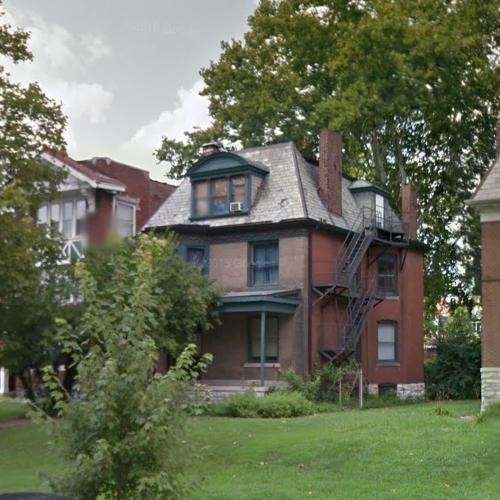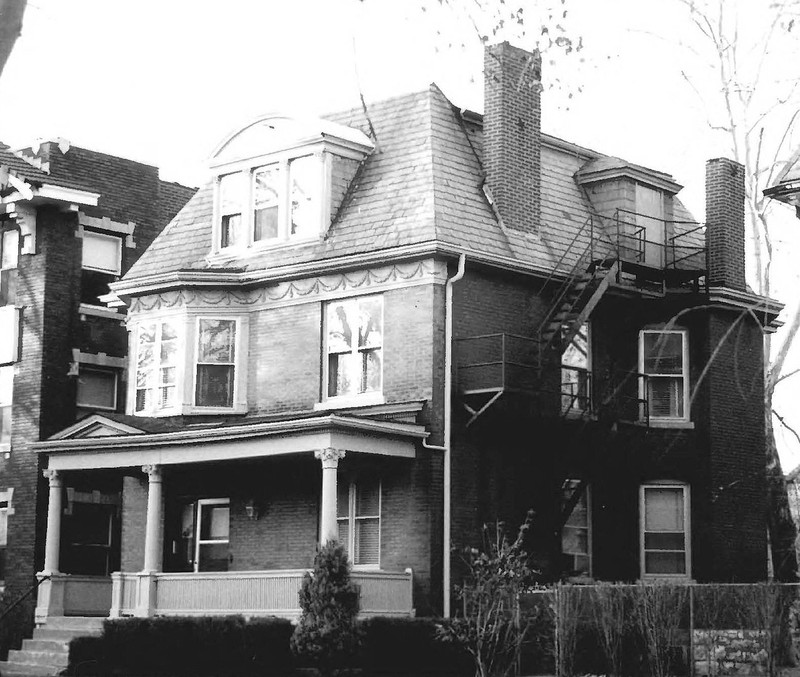Joseph Erlanger House
Introduction
Text-to-speech Audio
This historic St. Louis house was constructed in 1903 and was home of the accomplished medical researcher Joseph Erlander (1876-1965) from 1917 until his death. A Johns Hopkins Medical School graduate, Erlanger stood as one of the foremost American physiologists of the early twentieth century. He shared the 1944 Nobel Prize in Medicine and Physiology for his discovery of the electrical nature of the human nervous system. Erlanger lived in the house from 1917 until his death in 1965. Erlanger researched the physiology of the heart and also studied the velocities of conduction in nerve fibers.
Images
2016 photo of the Joseph Erlanger House

1979 photo of the Joseph Erlanger House

Backstory and Context
Text-to-speech Audio
Joseph Erlanger's father immigrated from Germany during the mid-nineteenth century. Joseph was born in 1876 in San Francisco, where he attended elementary and two years of high school before gaining an early admittance to the University of California in 1891. Erlanger entered the University's pre-med program. He graduated in 1895 with an excellent academic record, which led to his admission to the new Johns Hopkins Medical School. William Welch, William Osier, Simon Flexnor, and others used German guidelines to restructure the medical-focused pedagogy at Johns Hopkins along German lines. Thus, more American students with aspirations of embarking on a medical career could receive a quality education as it no longer became necessary to study abroad. As the early twentieth century progressed, Johns Hopkins graduates, including Erlanger, steadily made more contributions to the medical field.
Rather than go home to San Francisco after graduation, or open what would have likely been a lucrative medical practice, Erlanger chose to become a medical researcher, and he also gained respect for his work as a cardiologist. He worked at Johns Hopkins from 1899 to 1906, many of those years under the direction of William H. Howell, one of the country's best physiologists. Howell influenced Erlanger to become a physiologist; Erlanger taught physiology from 1903 to 1906 while simultaneously conducting research. The University of Wisconsin hired Erlanger in 1906 to teach and create two departments: physiology and physical chemistry. After only four years, Erlanger accepted an offer in 1910 to be a professor and head of the department of physiology in the school of medicine at Washington University of St. Louis. Although it was a short stay, he met Herbert S. Gasser while in Wisconsin; the two went on to do groundbreaking research in neurophysiology.
Erlanger initially researched the physiology of the heart. He invented a graphic method for measuring blood pressure and studied the nature of conduction in the heart. But, he gained fame after collaborating with Herbert Spencer Gasser and discovering during the early 1920s the different velocities of conduction in nerve fibers of different diameters. Physiologists had suspected for years that electrical charges in nerves arose at the surface membrane, but they had not measured the charges. Erlanger and Gasser accurately measured the electrical charges by building and using a cathode ray oscillograph, which amplified the detected current.
Erlanger continued working many years after retirement. Along with his Nobel Prize, Joseph Erlanger won numerous prestigious awards and held honorary degrees from seven universities. Among the many scientific organizations that elected him to membership were the National Academy of Sciences, the American Philosophical Society, and the American Association for the Advancement of Science. Erlanger was a leading member of the American Physiological Society and served as the group's president from 1926 to 1929.
The historic house that Erlanger called home was built in 1903. Its location near the Forest Park area speaks to the influence of the St. Louis World's Fair (Louisiana Purchase Exposition), which led investors to build abundantly near the Forest Park area, home to the Fair. Dr. Joseph Erlanger purchased the home in 1917 while working at Washington University in St. Louis; he continued to live there until he died in 1965 at the age of 89.
Sources
"Biography." Nobel Lectures, Physiology or Medicine 1942-1962, Amsterdam: Elsevier Publishing Company, 1964. The autobiography/biography was first published in the book series Les Prix Nobel. http://neurosciences.us/courses/systems/Nobels/1944%20Erlanger%20&%20Gasser/Erlanger/Erlanger%20Biography.pdf.
"Joseph Erlanger House National Historic Landmark." City of St. Louis. stlouis-mo.gov. Accessed August 27, 2022. https://www.stlouis-mo.gov/government/departments/planning/cultural-resources/Joseph-Erlanger-House-National-Historic-Landmark.cfm.
Nobel Prize for Physiology and Medicine for 1944: Prof. J. Erlanger and Dr. H. S. Gasser. Nature 154, 572 (1944). https://doi.org/10.1038/154572a0.
Sheire, James. "Nomination Form: James Erlanger House." National Register of Historic Places. nps.gov. 1976. https://npgallery.nps.gov/NRHP/GetAsset/NHLS/76002234_text.
Google Streetview capture, via Virtual Globetrotting: https://virtualglobetrotting.com/map/joseph-erlanger-house/
By Unknown author - http://pdfhost.focus.nps.gov/docs/NHLS/Photos/76002234.pdf, Public Domain, https://commons.wikimedia.org/w/index.php?curid=7217311
